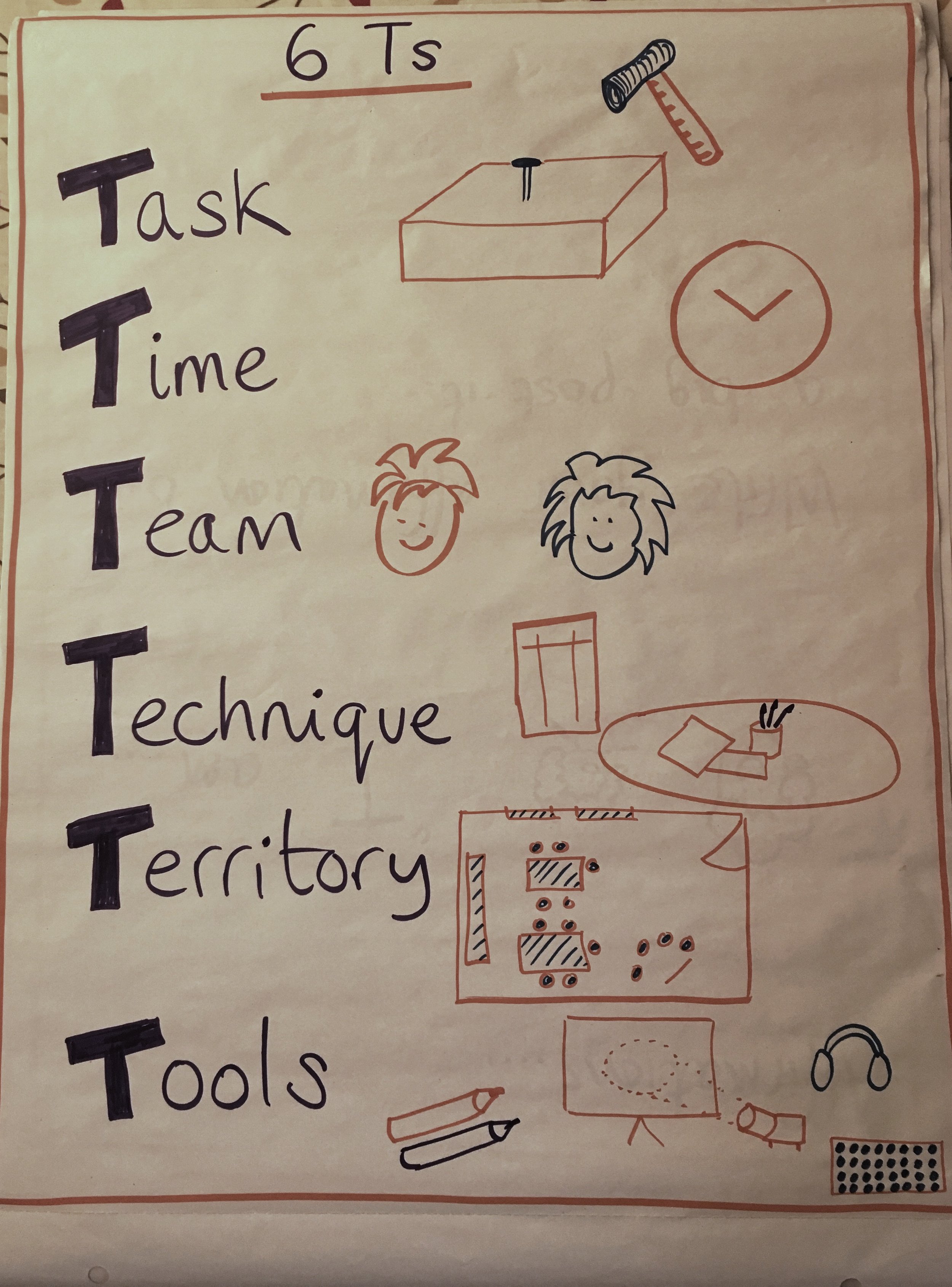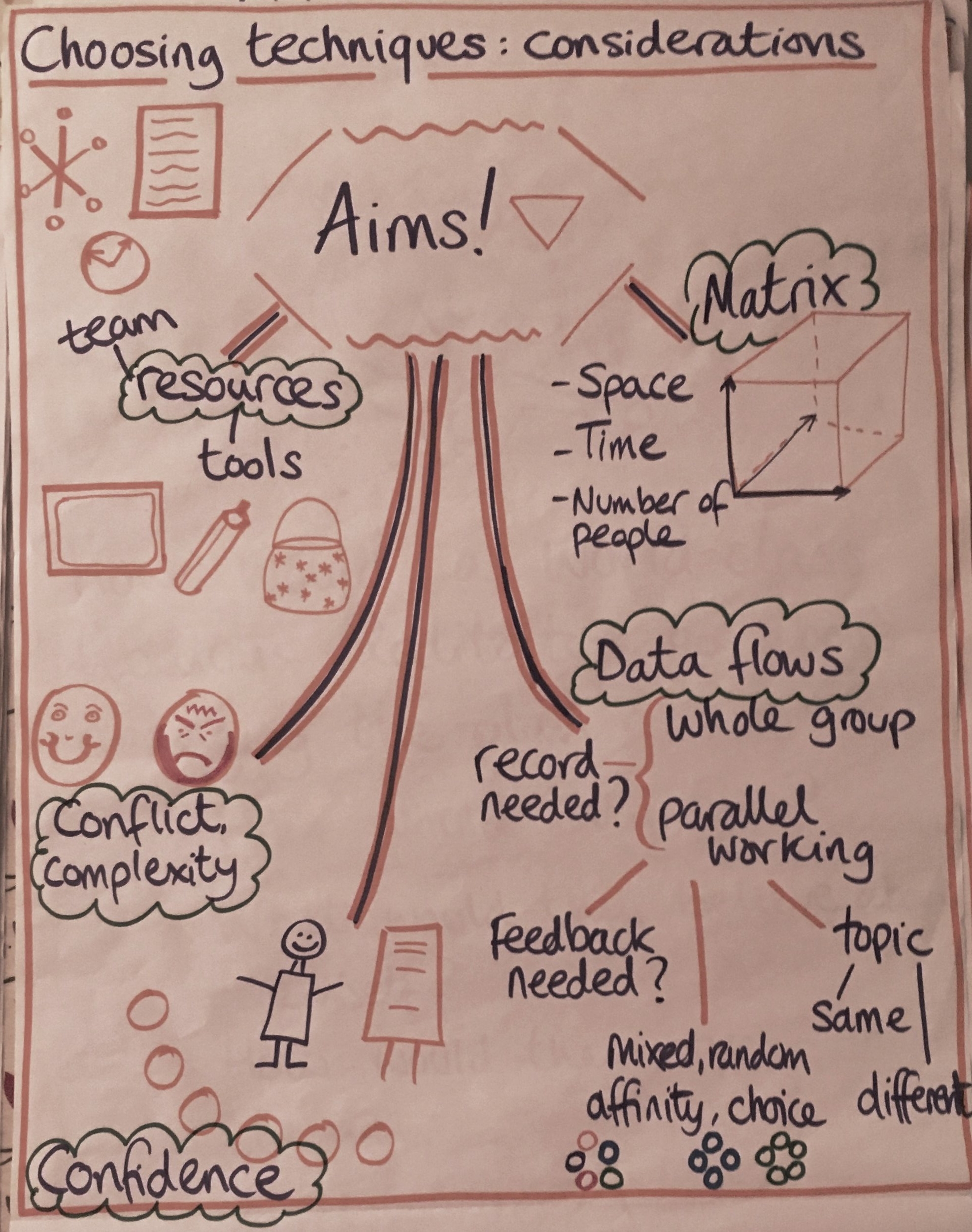Any fool can design a workshop. What really tests you is having to redesign it part-way through.
You’ve done a great plan, and prepared your materials. You know how you’d like the space laid out, and your workshop will take the group on a journey towards a convergent, satisfying conclusion.
And then it all goes horribly wrong. Nasty surprises throw your plans into disarray. You need to redesign and you need to do it NOW!
On the spot: Skitter photo https://www.pexels.com/photo/black-and-white-cartoon-donald-duck-spotlight-3706/
For some of us, this is our worst nightmare as a facilitator.
How can you make redesigning on the spot your most satisfying skill?
Why would you redesign?
I can’t be the only facilitator who carries blu-tack, masking tape, selotape, Velcro stickies, map pins AND thumb tacks in my toolkit. Alongside the thumb drive with a backup version of the presenter’s slides on them, and a print-out in case we need to recreate the slides on flip charts. Not to mention painkillers, plasters, tampons…
But sometimes, despite these contingencies, we still need to redesign.
I was training facilitators recently, and we spent a good chunk of time looking at redesigning and contingency planning. They generated a list of reasons why you might need to redesign a workshop once it had already started.
Technical issues - e.g. projector fails;
Your speaker or some other important team member is late;
An unexpected expert, senior leader or other significant stakeholder turns up;
Lower (or higher) number of participants than planned for;
Something takes longer than planned;
The group wants to add something to the aims or agenda;
Your realise there's a better way to meet the aims;
The format isn't working e.g. a plenary is being dominated.
I can imagine (and remember) these happening!
Real redesign
At an internal workshop with a regulated utility recently, we had a beautiful process which assumed that the three pilots trying out a new approach, would have a lot of things to action plan individually. It turned out that the most pressing topics for discussion were the cross-cutting enabling context which the organisation needed to provide, to let the pilots flourish. So not much point keeping them in three sub-groups for the hour that we’d scheduled. We conferred over lunch, and redesigned the afternoon, complete with new slides and room layout, so that they could have the conversation that wanted to happen. I was working with a very experienced support facilitator and there was a good level of trust in the client / facilitator team, meaning we could use the lunch break knock ideas around, decide what to do and then implement the new design fast.
Planned redesign
Sometimes you plan in the flexibility, because you know that you don’t know!
Last autumn, I designed and facilitated a workshop for a household name business with a reputation as a pioneer in sustainability. They assembled an amazing group of thought-leaders together with young future leaders and key decision-makers in their business. Over two days, we did lots of cool and interesting things, leading at lunchtime on the second day to an enormous clustered set of answers to the question “what should we look at in more detail this afternoon?” The group used sticky dots to show their areas of most interest.
The client / facilitation team spent lunchtime agreeing six topic areas, each with its own tailored questions beautifully written out on flips, which the group then worked on for two hours in the afternoon. We knew in advance that we would be designing and prepping for the afternoon during lunch. We expected that the session would include small group work and we knew the maximum number of groups our team and the space could accommodate. We knew how much time we had. But we couldn’t anticipate how many topics, what they would be, what kind of questions we'd want the group to ask themselves in relation to those topics and whether we would be working on different topics or all on the same topic.
How would a world-class fabulous facilitator approach redesigning a workshop?
I wanted to make the trainees feel really positive about redesigning things, so we spent a bit of time thinking about what helps you to redesign really well, and what gets in the way. We pictured how a 'world class fabulous facilitator' would approach rapid in-room redesign.
The group decided that the fabulous facilitator would be comfortable with change, confident and positive about their new plan. They would have a level of detachment - no-one is doing to die if they do a less than fabulous job! They would be calm, light-hearted and authoritative. They would use their quick-thinking skills to choose from a range of tools which are appropriate to help the group reach its goals: keeping the bigger picture in mind. They communicate clearly so the group accepts and is also confident in the new plan. We talked about the different circumstances in which the group might be involved in the redesign - sometimes the group won't even realise that a redesign has happened. Sometimes they will need to be actively involved in choosing the way forward.
Yes, and
There's some useful insights into becoming comfortable with making choices rapidly, from the world of improv. I'll blog about these another time but in the meantime here's a list.
Yes, and
Listen, observe
Trust, assume good intent, assume genius
Stay in the moment
Make others look good – play to enjoy, not to win
Be bold, mis-take cheerfully, embrace the unintended
6Ts, considerations
When you are redesigning, you need to pay attention to the same considerations as when you do your initial design - it's just that you have fewer choices and more fixed points. You know who your team are, what the room is like, how much conflict there is and so on, instead of having to make assumptions. (6Ts comes from 3KQ's foundational facilitation training.)
So you need to rely on techniques you are familiar with and more than ever bear in mind the rule of thumb - if in doubt, chose the simplest technique which will do the job.
You can do this!
Redesigning 'on the spot' is something that many new facilitators fear. Don't be afraid! You probably have done this before, so you know you can. Now you can get ever better at responding beautifully in the moment to the unfolding reality of the conversation you are helping to emerge.



